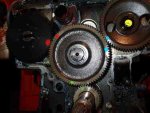The precombustion chambers from the bottom or cylinder side look like nickel sized circles of machined versus cast metal. I figured this was sort of a bottom plate of hardened metal. From what you are saying these are actually more of a complete chamber insert than a bottom plate and can be removed and installed?
Any ideas on a feasible technique of removal and installation. How about driving the chamber out using a drift through the injector hole? I have the old head to experiment with, but if I screw it up I wouldn't have one to put into the new head.
Would it be best to take the head to a machine shop to remove and press in?
However, I just remembered this is all moot. One of the visible cracks in the old head is in the bottom of the precombustion chamber. Plus, another precombustion chamber that the machinist showed me had what were most likely minute stress cracks in the prechamber gullet leading into the cylinder based on the magnaflux markings.
Since Wolfman's idea sadly doesn't appear an option suggestions on where do I go from here?
If the prechamber inserts are removable, can they be tweaked by a machine shop to decrease the volume by a couple of cc's.
What is the possibility that rebuilding the bottom end will beef up the compression enough to running condition. This could eventually need to be done some time in the future anyway if the tractor continued to be serviceable.
Install the thinner head gasket and see if it runs enough to give to my brother in-law.
Purchase a used Kubota rebuilt head that should have the smaller prechambers as OEM (I know where one is) versus using the Kumar brothers new head that I have. Try to Ebay this head that would work fine for most needs.
Scrounge the bowels of the internet to find another cracked head that would have the smaller prechamber inserts to replace the ones in the new head. Doubtful.
Part out the tractor and cut my losses.
Any ideas on a feasible technique of removal and installation. How about driving the chamber out using a drift through the injector hole? I have the old head to experiment with, but if I screw it up I wouldn't have one to put into the new head.
Would it be best to take the head to a machine shop to remove and press in?
However, I just remembered this is all moot. One of the visible cracks in the old head is in the bottom of the precombustion chamber. Plus, another precombustion chamber that the machinist showed me had what were most likely minute stress cracks in the prechamber gullet leading into the cylinder based on the magnaflux markings.
Since Wolfman's idea sadly doesn't appear an option suggestions on where do I go from here?
If the prechamber inserts are removable, can they be tweaked by a machine shop to decrease the volume by a couple of cc's.
What is the possibility that rebuilding the bottom end will beef up the compression enough to running condition. This could eventually need to be done some time in the future anyway if the tractor continued to be serviceable.
Install the thinner head gasket and see if it runs enough to give to my brother in-law.
Purchase a used Kubota rebuilt head that should have the smaller prechambers as OEM (I know where one is) versus using the Kumar brothers new head that I have. Try to Ebay this head that would work fine for most needs.
Scrounge the bowels of the internet to find another cracked head that would have the smaller prechamber inserts to replace the ones in the new head. Doubtful.
Part out the tractor and cut my losses.


